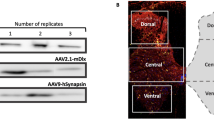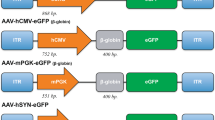Abstract
Endogenous opiate peptides acting pre- and post-synaptically in the dorsal horn of spinal cord inhibit transmission of nociceptive stimuli. We transfected neurons of the dorsal root ganglion in vivo by footpad inoculation with 30 μl (3 × 107 p.f.u.) of a replication-incompetent (ICP4-deleted) herpes simplex virus (HSV) vector with a cassette containing a portion of the human proenkephalin gene coding for 5 met- and 1 leu-enkephalin molecules under the control of the human cytomegalovirus immediate–early promoter (HCMV IEp) inserted in the HSV thymidine kinase (tk) locus. Vector-directed expression of enkephalin produced a significant antinociceptive effect measured by the formalin footpad test, that was most prominent in the delayed (‘tonic’) phase 20–70 min after the administration of formalin. The magnitude of the antinociceptive effect diminished over 4 weeks after transduction, but reinoculation of the vector reestablished the analgesic effect, without evidence for the development of tolerance. The antinociceptive effect was blocked completely by intrathecal naltrexone. These results suggest that gene therapy with an enkephalin-producing herpes-based vector may prove useful in the treatment of pain.
This is a preview of subscription content, access via your institution
Access options
Subscribe to this journal
Receive 12 print issues and online access
$259.00 per year
only $21.58 per issue
Buy this article
- Purchase on Springer Link
- Instant access to full article PDF
Prices may be subject to local taxes which are calculated during checkout



Similar content being viewed by others
References
Pasternak GW . Pharmacological mechanisms of opioidanalgesics Clin Neuropharmacol 1993 16: 1–18
Olson GA, Olson RD, Vaccarino AL, Kastin AJ . Endogenousopiates: 1997 Peptides 1998 19: 1791–1843
Yaksh TL . Pharmacology and mechanisms of opioid analgesic activity Acta Anaesthesiol Scand 1997 41: 94–111
Pohl M et al. Enkephalinergic and dynorphinergic neurons in the spinal cord and dorsal root ganglia of the polyarthritic rat – in vivo release and cDNA hybridization studies Brain Res 1997 749: 18–28
Jones SL, Sedivec MJ, Light AR . Effects of iontophoresed opioids on physiologically characterized laminae I and II dorsal horn neurons in the cat spinal cord Brain Res 1990 532: 160–174
Grudt TJ, Williams JT . mu-Opioid agonists inhibit spinal trigeminal substantia gelatinosa neurons in guinea pig and rat J Neurosci 1994 14: 1646–1654
Willcockson WS et al. Actions of opioids on primate spinothalamic tract neurons J Neurosci 1986 6: 2509–2520
Macdonald RL, Nelson PG . Specific-opiate-induced depression of transmitter release from dorsal root ganglion cells in culture Science 1978 199: 1449–1451
Werz MA, Grega DS, MacDonald RL . Actions of mu, delta and kappa opioid agonists and antagonists on mouse primary afferent neurons in culture J Pharmacol Exp Ther 1987 243: 258–263
Jeftinija S . Enkephalins modulate excitatory synaptic transmission in the superficial dorsal horn by acting at mu-opioid receptor sites Brain Res 1988 460: 260–268
Pohl M et al. Opioid control of the in vitro release of calcitonin gene-related peptide from primary afferent fibres projecting in the rat cervical cord Neuropeptides 1989 14: 151–159
Yaksh TL et al. Intrathecal morphine inhibits substance P release from mammalian spinal cord in vivo Nature 1980 286: 155–157
Millan MJ . The induction of pain: an integrative review Prog Neurobiol 1999 57: 1–164
Cesselin F . Opioid and anti-opioid peptides Fundam Clin Pharmacol 1995 9: 409–433
Ward Y et al. Control of MAP kiase activation by the mitogen-induced threonine/tyrosine phosphatase PACI Nature 1994 367: 651–657
Roizman B, Sears A . Herpes simplex viruses and their replication. In: Fields BN et al. (eds) Fields Virology Lippincott-Raven: Philadelphia 1996 2231–2295
Fink DJ, DeLuca NA, Glorioso JC . Gene transfer to neurons using herpes simplex virus-based vectors Ann Rev Neurosci 1996 19: 265–287
Krisky DM et al. Deletion of multiple immediate–early genes from herpes simplex virus reduces cytotoxicity and permits long-term gene expression in neurons Gene Therapy 1998 5: 1593–1603
Wolfe D et al. Engineering herpes simplex virus vectors for CNS applications Exp Neurol 1999 159: 34–46
Goins WF et al. Herpes simplex virus type 1 vector-mediated expression of nerve growth factor protects dorsal root ganglion neurons from peroxide toxicity J Virol 1999 73: 519–532
Yamada M et al. Herpes simplex virus vector-mediated expression of Bcl-2 prevents 6-hydroxydopamine-induced degeneration of neurons in the substantia nigra in vivo Proc Natl Acad Sci USA 1999 96: 4078–4083
Dubuisson D, Dennis SG . The formalin test: a quantitative study of the analgesic effects of morphine, meperidine, and brain stem stimulation in rats and cats Pain 1977 4: 161–174
Fink DJ, Glorioso JC . Herpes simplex virus-based vectors: problems and some solutions Adv Neurol 1997 72: 149–156
Fink DJ, DeLuca NA, Goins WF, Glorioso JC . Gene transfer to neurons using herpes simplex virus-based vectors Annu Rev Neurosci 1996 19: 265–287
Wilson SP et al. Antihyperalgesic effects of infection with a preproenkephalin-encoding herpes virus Proc Natl Acad Sci USA 1999 96: 3211–3216
Finegold AA, Mannes AJ, Iadarola MJ . A paracrine paradigm for in vivo gene therapy in the central nervous system: treatment of chronic pain Hum Gene Ther 1999 10: 1251–1257
Beutler AS et al. Retrovirus-mediated expression of an artificial beta-endorphin precursor in primary fibroblasts J Neurochem 1995 64: 475–481
Wang H, Sagen J . Absence of appreciable tolerance and morphine cross-tolerance in rats with adrenal medullary transplants in the spinal cord Neuropharmacology 1994 33: 681–692
Winnie AP et al. Subarachnoid adrenal medullary transplants for terminal cancer pain. A report of preliminary studies (see comments) Anesthesiology 1993 79: 644–653
Wu HH, McLoon SC, Wilcox GL . Antinociception following implantation of AtT-20 and genetically modified AtT-20/hENK cells in rat spinal cord J Neural Transplant Plast 1993 4: 15–26
Wu HH, Wilcox GL, McLoon SC . Implantation of AtT-20 or genetically modified AtT-20/hENK cells in mouse spinal cord induced antinociception and opioid tolerance J Neurosci 1994 14: 4806–4814
Chang JK, Fong BT, Pert A, Pert CB . Opiate receptor affinities and behavioral effects of enkephalin: structure-activity relationship of ten synthetic peptide analogues Life Sci 1976 18: 1473–1481
Belluzzi JD et al. Analgesia induced in vivo by central administration of enkephalin in rat Nature 1976 260: 625–626
Waksman G, Hamel E, Fournie-Zaluski MC, Roques BP . Autoradiographic comparison of the distribution of the neutral endopeptidase ‘enkephalinase’ and of mu and delta opioid receptors in rat brain Proc Natl Acad Sci USA 1986 83: 1523–1527
Schug SA, Zech D, Grond S . Adverse effects of systemic opioid analgesics Drug Saf 1992 7: 200–213
Carlton SM, Coggeshall RE . Nociceptive integration: does it have a peripheral component Pain Forum 1998 7: 71–78
Hassan AH, Ableitner A, Stein C, Herz A . Inflammation of the rat paw enhances axonal transport of opioid receptors in the sciatic nerve and increases their density in the inflamed tissue Neuroscience 1993 55: 185–195
Stein C . The control of pain in peripheral tissue by opioids N Engl J Med 1995 332: 1685–1690
Levine JD, Taiwo YO . Involvement of the mu-opiate receptor in peripheral analgesia Neuroscience 1989 32: 571–575
Goins WF et al. A novel latency active promoter is contained within the herpes simplex virus type 1 UL flanking repeats J Virol 1994 68: 2239–2252
Liu F, Housley PR, Wilson SP . Initial processing of human proenkephalin in bovine chromaffin cells J Neurochem 1996 67: 1457–1462
DeLuca NA, McCarthy AM, Schaffer PA . Isolation and characterization of deletion mutants of herpes simplex virus type 1 in the gene encoding immediate-early regulatory protein ICP4 J Virol 1985 56: 558–570
Rasty S, Goins WF, Glorioso JC . Site-specific integration of multigenic shuttle plasmids into the herpes simplex virus type 1 (HSV-1) genome using a cell-free Cre–lox recombination system. In: Adolph KW (ed.) Methods in Molecular Genetics, vol 7 Academic Press: London 1995 114–130
Gage PJ, Sauer B, Levine M, Glorioso JC . A cell-free recombination system for site-specific integration of multigenic shuttle plasmids into the herpes simplex virus type 1 genome J Virol 1992 66: 5509–5515
Mestre C et al. A method to perform direct transcutaneous intrathecal injection in rats J Pharmacol Toxicol Meth 1994 32: 197–200
Acknowledgements
We gratefully acknowledge the advice and guidance provided by Drs Ken Casey and Thomas Morrow, from the Department of Neurology at the University of Michigan. We wish to thank Ms Wei Chen and Ms Makiko Hartman for their excellent technical assistance. This work was supported by grants from the NIH (DJF and JCG), Department of Veterans Affairs (DJF), and the GenVec Corporation (DJF and JCG).
Author information
Authors and Affiliations
Rights and permissions
About this article
Cite this article
Goss, J., Mata, M., Goins, W. et al. Antinociceptive effect of a genomic herpes simplex virus-based vector expressing human proenkephalin in rat dorsal root ganglion. Gene Ther 8, 551–556 (2001). https://doi.org/10.1038/sj.gt.3301430
Received:
Accepted:
Published:
Issue Date:
DOI: https://doi.org/10.1038/sj.gt.3301430
Keywords
This article is cited by
-
Attenuation of myogenic orofacial nociception and mechanical hypersensitivity by viral mediated enkephalin overproduction in male and female rats
BMC Neurology (2015)
-
Viral Vectors Encoding Endomorphins and Serine Histogranin Attenuate Neuropathic Pain Symptoms after Spinal Cord Injury in Rats
Molecular Pain (2015)
-
Preclinical Toxicity Evaluation of AAV for Pain: Evidence from Human AAV Studies and from the Pharmacology of Analgesic Drugs
Molecular Pain (2014)
-
Relief of pain induced by varicella-zoster virus in a rat model of post-herpetic neuralgia using a herpes simplex virus vector expressing enkephalin
Gene Therapy (2014)
-
HSV-mediated p55TNFSR reduces neuropathic pain induced by HIV gp120 in rats through CXCR4 activity
Gene Therapy (2014)



